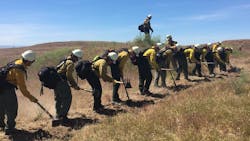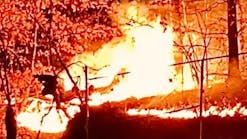ID Firefighters Prepare for Hot Wildfire Season
By Colin Tiernan
Source The Times-News, Twin Falls, Idaho
TWIN FALLS, ID—They hack at the ground in concert, gradually snaking their way through the grassland like a digging chorus line and leaving a bare swath of fire resistant dirt in their wake.
Then, in their helmets, boots, rugged pants and thick yellow shirts, the firefighters run to the safe zone and hide themselves in bright green training shelters. Each spends a few minutes in her shelter, baking under the noon sun. After a long five minutes, they emerge, covered in sweat, like moths from cocoons.
The Bureau of Land Management Twin Falls District Fire Management program runs its 80-plus firefighters through a training gauntlet every year to prepare for fire season, which typically runs from June through September. More than 80 firefighters trained for shelter deployment, water pumping, medical response and search and rescue on Tuesday.
“What we do is dangerous, so we have to train, train, train so that we can be ready if the worst case scenario were to happen,” BLM Firefighter Type I Mesa Heimerdinger said.
National Weather Service Fire Weather Meteorologist Chuck Redman said that the fire season is likely to start late this year.
“The grasses are still fairly green and the sagebrush is still kind of sucking up some moisture,” he explained. “(Fire season) is going to be a couple of weeks delayed for the BLM (land) and probably a month or so up in the mountains.”
Precipitation levels play a significant role in fire severity, Redman said. This year has seen heavy snowfall and a rainy May.
Higher precipitation leads to greater grass growth. More grass means more fuel for fires.
“That’s going to be the big problem on the BLM (land) … the grass crop,” Redman said.
BLM Twin Falls District Fire Safety and Training Manager Clay Stephens said that the amount of fuel on the landscape in the Twin Falls area makes fighting local fires a challenge.
“It doesn’t take anything to carry it (a fire),” he said. “Then you add a little wind to that factor and it can get pretty crazy.
“If you see firefighters, and they look a little beat down, they might be, so give them a high five.”
BLM Twin Falls District spokeswoman Kelsey Brizendine said that the past two fire seasons have been of average severity. Higher than usual precipitation and grass growth could play a role this year, but Brizendine said she’s unsure what the season might look like.
“The fuel loading is there,” she said. “But until we start getting fires there’s no way to know what the fire season will be like.”
The number of fires depends on the number of sparks.
“You can have all the fuel in the world sitting right here, and unless we get the lightning it’s not going to burn,” Brizendine explained.
Redman said that ensuring adequate space between structures is critical in preventing and fighting fires. He also pointed out that severe fires have become increasingly common in recent years.
“What is normal these days?” he said. “Each year it just keeps getting bigger and bigger.”
———
©2019 The Times-News (Twin Falls, Idaho)
Visit The Times-News (Twin Falls, Idaho) at magicvalley.com
Distributed by Tribune Content Agency, LLC.






